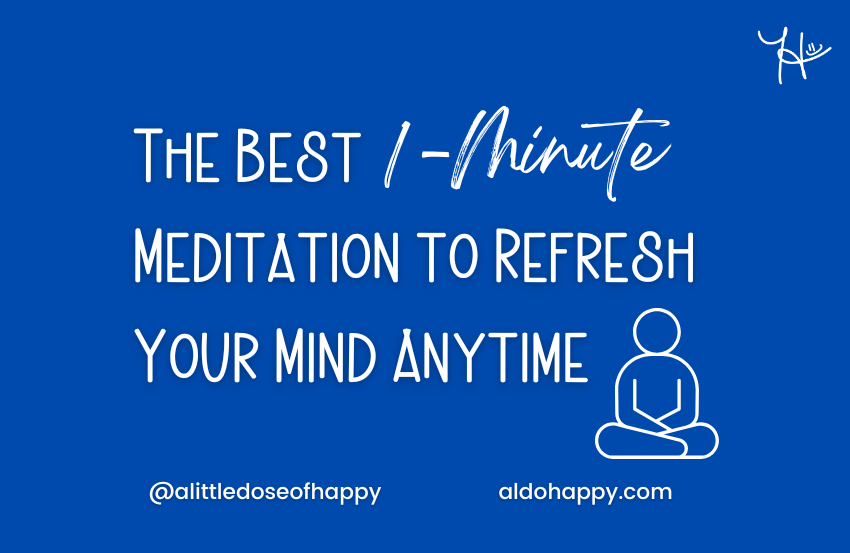The Best 1-Minute Meditation to Refresh Your Mind Anytime
“When I have time…” How many times have you said those words? We all do it – putting off self-care until that mythical moment when life gets less busy. When the to-do list shrinks. When work settles down. When the kids are older.
But here’s the truth: that “perfect time” never comes. And sometimes, it takes a wake-up call – like feeling overwhelmed in a crowded store or freezing before an important meeting – to realize we need a different approach.
Here’s the game-changing secret: you don’t need to find time. You already have it. Just one minute between meetings or while your coffee brews is all you need. And the most powerful way to use these moments? Meditation. When you have a free minute, intentional breathing or mindfulness will serve you better than scrolling through social media or worrying about your growing to-do list.
Let’s explore how a 1-minute meditation can fit seamlessly into your busiest days – no schedule overhaul required.

Why One-Minute Meditation Works (And Why You Need It)
Think meditation requires 30 minutes of silence in a zen garden? Think again. A one-minute meditation practice packs surprising power into 60 seconds.
Here’s what makes it special:
- Instant Accessibility: No special equipment or quiet room needed
- Science-Backed Results: Research shows even brief mindfulness exercises trigger positive brain changes
- Perfect for Busy Lives: Transform spare minutes in the present moment into powerful mental reset points
The Science Behind Your 60 Seconds of Calm
Research shows that mindfulness practices can create remarkable changes in our brain and body. A 2024 systematic review revealed that meditation can reduce reactivity in the amygdala (our brain’s alarm center), improve brain connectivity, and enhance emotional control.
When you take a mindful moment, several powerful shifts occur:
✓ Stress Response
- Mindful breathing shifts your body from “fight or flight” mode into “rest and digest” mode
- This natural calming system acts like your body’s brake pedal, helping you slow down the stress response
- It’s like finding your body’s natural calm button
✓ Emotional Balance
- Mindfulness helps calm the brain’s emotional alarm system
- It’s like having a better grip on your emotional steering wheel
- Think of it as upgrading your ability to respond rather than react
✓ Mental Clarity
- Taking mindful pauses helps reduce mental clutter
- It’s similar to closing unnecessary tabs in your mental browser
- Imagine clearing the fog from your mental windshield
Even brief moments of mindful breathing can trigger what scientists call the ‘relaxation response‘ – your body’s natural state of rest that’s opposite to the stress response.
While most research focuses on longer meditation practices, these findings hint at the potential of mindful moments. Think of it like exercise – even a quick stretch is better than no movement at all. The key is consistency rather than duration.
The Benefits: From Immediate Relief to Lasting Change
Like dropping a pebble in a pond, your one-minute practice creates ripples of positive change. The effects begin immediately and build over time with regular practice.
Immediate Benefits
- Instant stress relief before big meetings
- Mental clarity during afternoon slumps
- Emotional reset after tense conversations
- Enhanced focus for important tasks
Long-Term Transformation
- Better sleep quality
- Improved emotional resilience
- Sharper concentration
- Reduced overall anxiety
- Enhanced self-awareness
- Stronger stress management skills
- Greater mind-body connection
Just as regular exercise strengthens your muscles, consistent brief meditation sessions help your brain build new pathways for finding calm under pressure. Each minute you spend in mindful awareness contributes to these lasting changes.
Your 60-Second Reset: Real-Life Integration
When to Use Your Minute
We often tell ourselves we don’t have time for things, but that’s exactly why one-minute meditation is so powerful – these brief moments of mindfulness can fit naturally into the rhythm of our day:
- 🌅 Morning: Think about your morning routine: instead of immediately reaching for your phone, you could use that first minute to set an intention for the day ahead.
- 💼 Pre-meeting: Before important meetings, take sixty seconds to center yourself and sharpen your focus.
- 😤 Post-conflict: After a tense conversation or conflict, a mindful minute helps you reset and return to a balanced state.
- 🌙 Bedtime: As your day winds down, a brief meditation can signal to your brain that it’s time to transition to rest, making it easier to fall asleep.
These transition points in your day aren’t interruptions – they’re natural opportunities to pause and reset. By recognizing these moments and using them intentionally, you transform ordinary waiting times into powerful moments of self-care. The beauty is that you’re not adding anything new to your schedule; you’re simply using the time you already have more mindfully.
Here are three proven techniques you can use in any of these moments:
Three Proven Techniques
1. The Basic Reset (Perfect for Beginners)
Think of this as your meditation starter pack—no fancy techniques required, just you and your breath.
Find a comfortable position (yes, even at your desk) and follow this simple process:
0-20 seconds: Quick Body Scan
- Start at the top of your head
- Notice any tension in your jaw (we often clench without realizing it)
- Drop your shoulders away from your ears (they’ve probably crept up)
- Soften your belly (let it relax like a sleeping cat)
- No need to change anything – just notice what’s there
21-40 seconds: Focus on Breathing
- Feel the natural rhythm of your breath
- Notice the cool air entering your nose
- Feel your belly rise and fall
- Don’t try to control it – just observe
- If your mind wanders (it will!), gently bring it back to your breath
41-60 seconds: Clear Mind & Set Intention
- Let your thoughts settle like snow in a snow globe
- Choose one word for your next activity, such as “Focus” for deep work, “Listen” for meetings, and “Patience” for challenging conversations
2. The S.T.O.P. Method (Great for Hectic Day Transitions)

Perfect for those moments when you’re jumping from task to task like a mental acrobat.
Stop what you’re doing.
- Literally, pause.
- Put down your phone.
- Step away from your keyboard.
- Create a physical break in the action.
Take a deep breath.
- Make it slow and intentional.
- Feel your lungs expand fully.
- Let your exhale be longer than your inhale.
- Think “filling up with calm, releasing the tension.”
Observe your current state.
- Check in with your body. (Tense? Tired? Wired?)
- Notice your emotions. (Frustrated? Anxious? Excited?)
- Scan your surroundings. (Noisy? Quiet? Busy?)
- No judgments – just gather information.
Proceed mindfully.
- Choose your next action deliberately.
- Move forward with awareness.
- Bring your refreshed attention to what’s next.
3. Box Breathing (Ideal for Stress Management)
Navy SEALs use this technique in high-pressure situations. If it works for them to achieve a calmer state before missions, it can work for your pre-presentation jitters.
Picture drawing a square in your mind as you:
Inhale (4 counts) – Draw the first line up
- Make it smooth and steady
- Fill your lungs from bottom to top
- Count: 1-2-3-4
Hold (4 counts) – Draw the line across
- Keep your shoulders relaxed
- Stay comfortable, not strained
- Count: 1-2-3-4
Exhale (4 counts) – Draw the line down
- Make it slow and controlled
- Let all the air flow out
- Count: 1-2-3-4
Hold (4 counts) – Draw the line across to complete the box
- Feel the natural pause
- Stay relaxed
- Count: 1-2-3-4
Just as everyone’s day unfolds differently, your approach to meditation is uniquely yours. These techniques are flexible guidelines rather than rigid rules – feel free to adapt them to your needs.
Tips for Success
To help make your meditation practice stick:
- Start Small: One scheduled minute daily beats sporadic longer sessions. Think of it like building a new habit – consistency matters more than duration.
- Use Triggers: Link your practice to your daily routine – whether it’s coffee breaks, checking email, or brushing your teeth. These natural cues make it easier to remember and maintain your practice.
- Try Guided Support: Using guided meditations can help you stay focused and learn proper techniques. Even experienced meditators sometimes prefer guided sessions for structure and variety.
- Stay Flexible: Mix between guided meditations and silent practice. Some days, you might need more guidance; others, you’ll prefer quiet reflection – both approaches have value.
- Track Progress: Notice small wins in stress response and focus. Maybe you’re handling tough meetings better or staying calmer in traffic – these subtle shifts show your practice is working.
Pro Tip: New to meditation? The Headspace app offers bite-sized, one-minute guided sessions perfect for beginners. Their expert guidance can help you build confidence in your practice.
Troubleshooting Your Practice
Even the simplest meditation practices can come with challenges, but they all have straightforward solutions. Here’s how to handle the most common ones:
- Common Challenge #1: “My mind won’t stop racing.” If you find your mind racing and unable to settle, try counting your breaths – it’s a simple technique that gives your mind just enough focus to help quiet those rushing thoughts.
- Common Challenge #2: “I keep forgetting.” Many people struggle with remembering to take their mindful minute; the solution is to set gentle reminders on your phone until the practice becomes as natural as checking your email or having your morning coffee.
- Common Challenge #3: “I feel self-conscious.” Feeling self-conscious about meditating, especially in public or at work, is perfectly normal. You might worry about what others think if they see you with your eyes closed at your desk. If this is a concern, try an eyes-open variation – from the outside, it simply looks like you’re taking a thoughtful pause in your day while you’re still able to engage in the full benefits of the practice.
Remember, meditation doesn’t always mean sitting cross-legged with closed eyes – it can be as subtle as mindfully sipping your coffee or taking a few conscious breaths between tasks.
Your Next Step: Start Now
Don’t wait for the “perfect moment” to begin your mindfulness journey. Your next minute is all you need. Here’s your simple start:
- Set your phone timer for 60 seconds
- Find a comfortable position
- Take one deep breath
- Follow your breath
- Notice how you feel afterward
You don’t need a complete life overhaul to start meditating – you just need the minutes you already have. Think of each sixty-second reset as an investment in your mental clarity and emotional balance. A regular meditation practice creates lasting change.
Ready to transform your day, one minute at a time? Your next peaceful moment is just sixty seconds away!

Want more mindfulness tips for your busy life? Explore the a little dose of happy blog for our collection of practical meditation and wellness articles written for real people with real schedules.
Here are some reader favorites to get you started:




